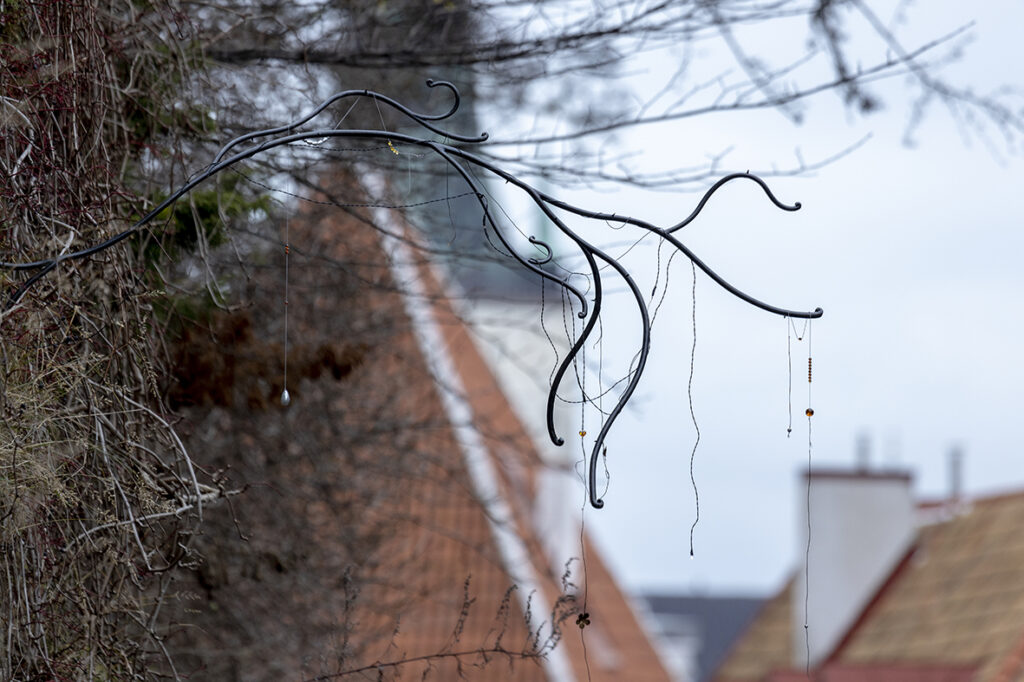
Anna Mari Liivrand (1993) is a sculptor and installation artist, who also works with drawing. She is a sensitive creator interested in the conventional use of everyday materials and related unconscious judgements. Using a poetic language, Liivrand explores evanescence and melancholy in today’s society. She has also looked at the fragility of art, and methods of preservation. In recent years, Liivrand has focused on everyday rituals.
In the 2017, Liivrand presented her solo exhibition “Unshatterable” at Hobusepea gallery. The title of the exhibition highlights the fact that laminated glass does not shatter when it breaks. The works at the show touched upon questions of preservation and conservation. The hanging talismans, created using fish oil capsules, brought to mind ways in which the human organism is held together, the glass wall and the abstract objects in it pointed to the existence of desires and ideas.
Liivrand addressed similar themes in her 2019 solo show “Beds and Ripples” at Draakon gallery, inspired by unusual ephemeral materials, questions of conservation, and everyday rituals. Liivrand used different colours, textures, and liquids, with a variety of textures to draw attention to the various properties of elements: in beds with a particular form, these can be decorative elements, when flowing freely, the same elements can be seen as kinetic sculptures. Installations, hanging talismans, and silk drawings created an ephemeral and melancholic atmosphere. The liquids used in these landscapes demonstrated Liivrand’s continuous interest in unusual and unstable materials, like marzipan (“untitled”, 2014); fish oil capsules; textile, incl. silk and wool; rose essence (“Landscape for Rose Tears”, 2018); cat hair (“Monument Valley (May Contain Artefacts)”, 2018).
The solo exhibition “Monument Valley (May Contain Artefacts)” at the Showcase Gallery of the Estonian Academy of Arts once again displayed Liivrand’s sensitive approach. Contextualising her work in the Contemporary Art Museum of Estonia and its surrounding area as a significant space in local history of architecture, Liivrand used stained glass and curious objects to create a temporary passage to a space where space can be experienced on a shifted scale.
Twice, Liivrand has showed her work together with Kati Saarits. In 2016, the exhibition “Fool’s Gold” at the Draakoni gallery, used the mineral pyrite as an image to draw attention to surface level resemblance, and to the relationship between shiny surfaces and internal value. The exhibition looked at desire, illusion, and overabundance in today’s society. In 2017, the collaborative exhibition with Saarits titled “Amber” was exhibited as a continuation of the creative dialogue between the two artists. The show was conceptually framed by the aesthetics of souvenir shops, craft practices, and traditions of collecting. The artists looked at amber in the context of tourism and folk art, pointing out the fact that the extensive amber trade has made the natural precious material into a cheap souvenir, and that in Estonia, the so-called Nordic gold is not meaningful as a souvenir as it is not a local material. Liivrand’s works looked at the sedimentation and solidification processes, amber’s ability to act as a “time capsule”.
Liivrand has also participated in several curated exhibitions. In the 2018 exhibition “Everyday Magic” (curated by Merilin Talumaa, at Kogo gallery), and “Post Winter Mixtape” (curated by Lilian Hiob, Temnikova & Kasela gallery), she presented a multilayered view of landscapes. In Kogo gallery, Liivrand exhibited “Landscape for Rose Tears”, an installation made of copper tubes, rose extract and a curtain, reminding us that scent is an invisible carrier of information that guides our experiences. In the exhibition “Post Winter Mixtape“ Liivrand exhibited “Ripple on a Field”, a two-part drawing, where elements of landscape meet still-life, creating a frozen atmosphere. In her later work, Liivrand has begun using contemporary ornaments. In 2020, she exhibited her work “Thorny Enchantment from the Field” at the 7th Artishok Biennale. The installations, located in Pikk street and Süda street in Tallinn, were fragile and ornamental imitations of branches with a flickering light at the heart of the pieces, referring to the will-o’-the-wisp that entices travellers to their death.
Anna Mari Liivrand graduated from the sculpture and installation department (BA, 2016) and contemporary art (MA, 2022) at the Estonian Academy of Arts and has also studied fine arts at Iceland University of Arts. In 2014, Liivrand received the Young Sculptor Prize. In addition to solo exhibitions, she has participated in numerous group shows, including the 7th Artishok Biennale. She was the recipient of Eduard Wiiralt prize in 2020. She was awarded with Estonian Cultural Endowment’s annual award (2021).